Discover 35 hidden attractions, cool sights, and unusual things to do in Chicago (United States). Don't miss out on these must-see attractions: Art Institute of Chicago, Field Museum, and Grant Park. Also, be sure to include Millennium Park in your itinerary.
Below, you can find the list of the most amazing places you should visit in Chicago (Illinois).
Table of Contents
Art Institute of Chicago
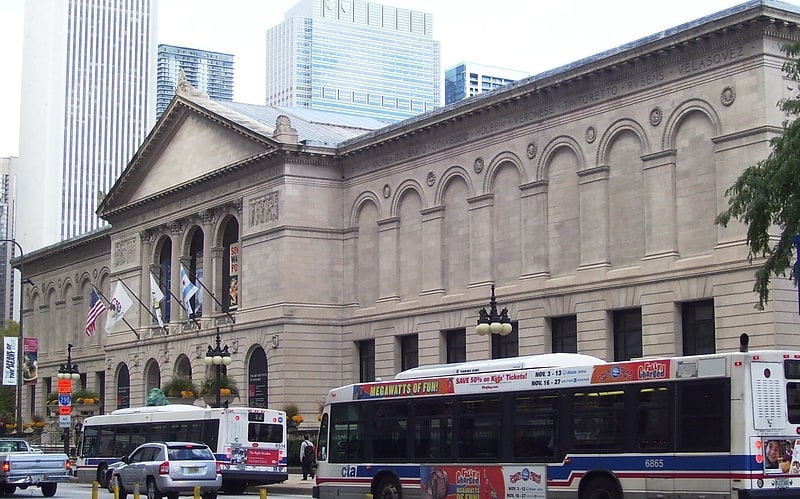
Renowned art museum with global works. The Art Institute of Chicago in Chicago's Grant Park, founded in 1879, is one of the oldest and largest art museums in the world. Recognized for its curatorial efforts and popularity among visitors, the museum hosts approximately 1.5 million people annually. Its collection, stewarded by 11 curatorial departments, is encyclopedic, and includes iconic works such as Georges Seurat's A Sunday on La Grande Jatte, Pablo Picasso's The Old Guitarist, Edward Hopper's Nighthawks, and Grant Wood's American Gothic. Its permanent collection of nearly 300,000 works of art is augmented by more than 30 special exhibitions mounted yearly that illuminate aspects of the collection and present cutting-edge curatorial and scientific research.
As a research institution, the Art Institute also has a conservation and conservation science department, five conservation laboratories, and one of the largest art history and architecture libraries in the country—the Ryerson and Burnham Libraries.
The growth of the collection has warranted several additions to the museum's 1893 building, which was constructed for the World's Columbian Exposition. The most recent expansion, the Modern Wing designed by Renzo Piano, opened in 2009 and increased the museum's footprint to nearly one million square feet, making it the second-largest art museum in the United States, after the Metropolitan Museum of Art. The Art Institute is associated with the School of the Art Institute of Chicago, a leading art school, making it one of the few remaining unified arts institutions in the United States.
In 2017, the Art Institute received 1,619,316 visitors, and was the 35th most-visited art museum in the world. However, in 2020, due to the COVID-19 pandemic, the museum was closed for 169 days, and attendance plunged by 78 percent from 2019, to 365,660.[1]
Address: 111 S Michigan Ave, 60603 Chicago (Downtown)
Field Museum
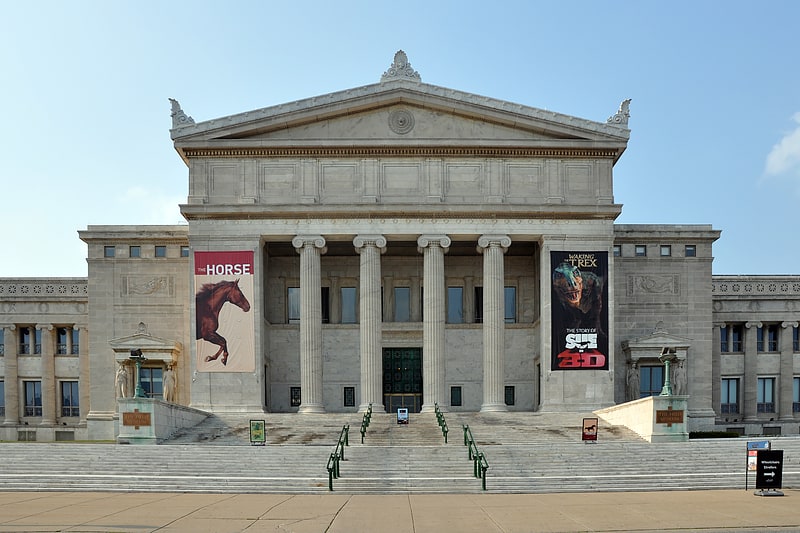
Museum in Chicago, Illinois. The Field Museum of Natural History, also known as The Field Museum, is a natural history museum in Chicago, Illinois, and is one of the largest such museums in the world. The museum is a popular natural-history museum for the size and quality of its educational and scientific programs, as well as due to its extensive scientific-specimen and artifact collections. The permanent exhibitions, which attract up to two million visitors annually, include fossils, current cultures from around the world, and interactive programming demonstrating today's urgent conservation needs. The museum is named in honor of its first major benefactor, the department-store magnate Marshall Field. The museum and its collections originated from the 1893 World's Columbian Exposition and the artifacts displayed at the fair.
The museum maintains a temporary exhibition program of traveling shows as well as in-house produced topical exhibitions. The professional staff maintains collections of over 24 million specimens and objects that provide the basis for the museum's scientific-research programs. These collections include the full range of existing biodiversity, gems, meteorites, fossils, and rich anthropological collections and cultural artifacts from around the globe. The museum's library, which contains over 275,000 books, journals, and photo archives focused on biological systematics, evolutionary biology, geology, archaeology, ethnology and material culture, supports the museum's academic-research faculty and exhibit development. The academic faculty and scientific staff engage in field expeditions, in biodiversity and cultural research on every continent, in local and foreign student training, and in stewardship of the rich specimen and artifact collections. They work in close collaboration with public programming exhibitions and education initiatives.[2]
Address: 1400 S Lake Shore Dr, 60605 Chicago (Downtown)
Grant Park
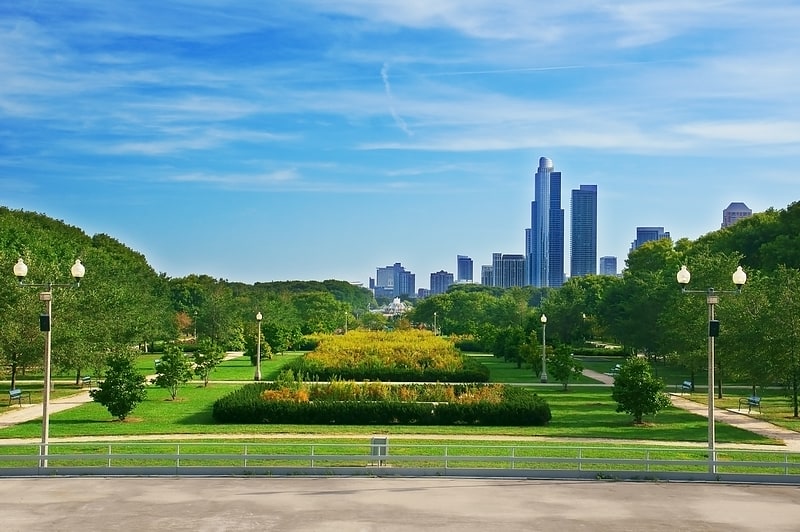
Home to numerous Downtown attractions. Grant Park is a large urban park in the Loop community area of Chicago, Illinois. Located within the city's central business district, the park's features include Millennium Park, Buckingham Fountain, the Art Institute of Chicago, and the Museum Campus. Originally known as Lake Park, and dating from the city's founding, it was renamed in 1901 to honor US President Ulysses S. Grant. The park's area has been expanded several times through land reclamation, and was the focus of several disputes in the late 19th century and early 20th century over open space use. It is bordered on the north by Randolph Street, on the south by Roosevelt Road and McFetridge Drive, on the west by Michigan Avenue and on the east by Lake Michigan. The park contains performance venues, gardens, art work, sporting, and harbor facilities. It hosts public gatherings and several large annual events.
Grant Park is popularly referred to as "Chicago's front yard". It is governed by the Chicago Park District.[3]
Address: 337 E Randolph Dr, 60601 Chicago (Downtown)
Millennium Park
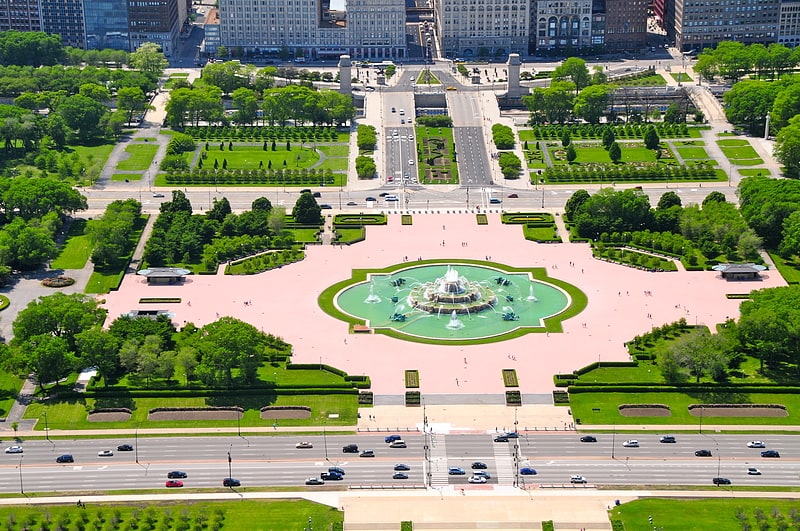
Green space with art, theater and ice rink. Millennium Park is a public park located in the Loop community area of Chicago, operated by the Chicago Department of Cultural Affairs. The park, intended to celebrate the third millennium, is a prominent civic center near the city's Lake Michigan shoreline that covers a 24.5-acre section of northwestern Grant Park.
Opened in 2004, the area was previously occupied by parkland, the Illinois Central rail yards, and parking lots. Featuring a variety of public art, outdoor spaces and venues, the park is bounded by Michigan Avenue, Randolph Street, Columbus Drive and East Monroe Drive. In 2015, the park became the location of the city's annual Christmas tree lighting.
Planning of the park began in October 1997. Construction began in October 1998, and Millennium Park was opened in a ceremony on July 16, 2004, four years behind schedule. The three-day opening celebrations were attended by some 300,000 people and included an inaugural concert by the Grant Park Orchestra and Chorus. The park has received awards for its accessibility and green design. Millennium Park has free admission, and features the Jay Pritzker Pavilion, Cloud Gate, the Crown Fountain, the Lurie Garden, and various other attractions. The park is connected by the BP Pedestrian Bridge and the Nichols Bridgeway to other parts of Grant Park. Because the park sits atop parking garages, the commuter rail Millennium Station and rail lines, it is considered the world's largest rooftop garden.
Some observers consider Millennium Park the city's most important project since the World's Columbian Exposition of 1893. It far exceeded its originally proposed budget of $150 million. The final cost of $475 million was borne by Chicago taxpayers and private donors. The city paid $270 million; private donors paid the rest, and assumed roughly half of the financial responsibility for the cost overruns. The construction delays and cost overruns were attributed to poor planning, many design changes, and cronyism. Many critics have praised the completed park.
In 2017, Millennium Park was the top tourist destination in Chicago and in the Midwest, and placed among the top ten in the United States with 25 million annual visitors.[4]
Address: 201 East Randolph Street, 60601-6530 Chicago (Downtown)
Adler Planetarium

Museum with high-tech exhibits and shows. The Adler Planetarium is a public museum dedicated to the study of astronomy and astrophysics. It was founded in 1930 by Chicago business leader Max Adler. It is located on the northeastern tip of Northerly Island at the shore of Lake Michigan in Chicago, Illinois. The Adler was the first planetarium in the United States and is part of Chicago's Museum Campus, which includes the John G. Shedd Aquarium and The Field Museum. The Adler's mission is to inspire exploration and understanding of the universe.
The Adler Planetarium opened to the public on May 12, 1930. For its design, architect Ernest A. Grunsfeld Jr. was awarded the gold medal of the Chicago chapter of the American Institute of Architects in 1931. It was declared a National Historic Landmark in 1987.
The Adler is home to three full size theaters, extensive space science exhibitions including the Gemini 12 space capsule, and a significant collection of antique scientific instruments and print materials. In addition, the Adler boasts the Doane Observatory, one of the only research-active, public urban observatories.
Outdoor sculptures at the planetarium include: Man Enters the Cosmos by Henry Moore (1980); Spiral Galaxy by John David Mooney (1998); and America's Courtyard by Ary Perez and Denise Milan.[5]
Address: 1300 S Lake Shore Dr, 60605 Chicago (Downtown)
Chicago History Museum
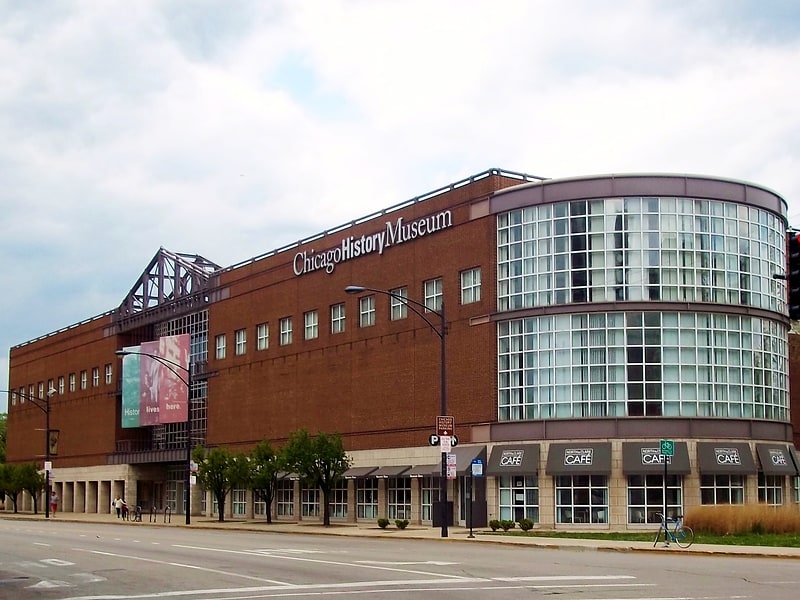
Chicago history brought to life. Chicago History Museum is the museum of the Chicago Historical Society. The CHS was founded in 1856 to study and interpret Chicago's history. The museum has been located in Lincoln Park since the 1930s at 1601 North Clark Street at the intersection of North Avenue in the Old Town Triangle neighborhood. The CHS adopted the name, Chicago History Museum, in September 2006 for its public presence.[6]
Address: 1601 N Clark St, 60614 Chicago (North Side)
Willis Tower
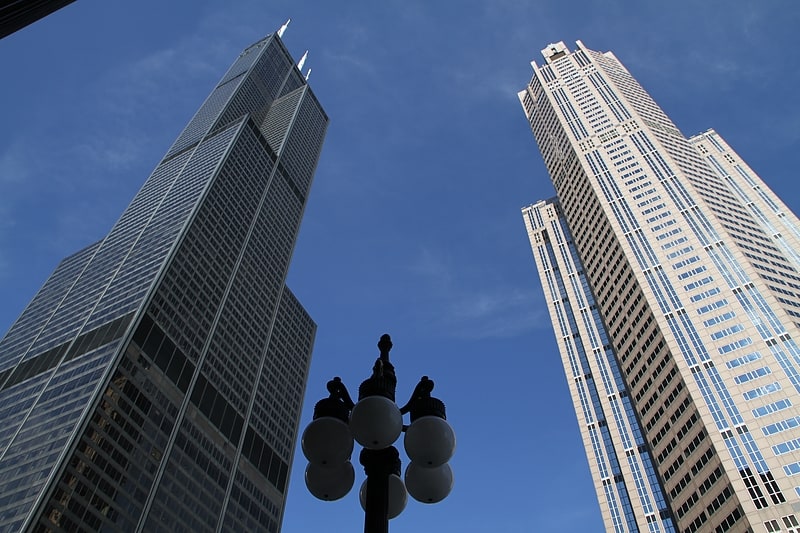
Super-tall skyscraper with city vistas. The Willis Tower is a 108-story, 1,450-foot skyscraper in Chicago. The tower has 108 stories as counted by standard methods, though the building's owners count the main roof as 109 and the mechanical penthouse roof as 110. At completion in 1974, it surpassed the World Trade Center in New York City to become the tallest building in the world, a title that it held for nearly 25 years. It was also the tallest building in the Western Hemisphere for 41 years, until the One World Trade Center surpassed it in 2013, and had the highest occupiable floor until surpassed by the Central Park Tower in 2022.
Willis Tower is considered a seminal achievement for engineer Fazlur Rahman Khan. It is currently the third-tallest building in the United States and the Western hemisphere – and the 23rd-tallest in the world. Each year, more than one million people visit its observation deck, the highest in the United States, making it one of Chicago's most popular tourist destinations.
As of April 2018, the building's largest tenant is United Airlines, which moved its corporate headquarters from 77 West Wacker Drive (then the United Building) in 2012, occupying around 20 floors. Other major tenants include the building's namesake Willis Towers Watson and law firms Schiff Hardin and Seyfarth Shaw. Morgan Stanley became the building's fourth-largest tenant in 2017.
Known as the Sears Tower from its construction until the naming rights were included in a 2009 lease with the Willis Group, it served as the headquarters of retail company Sears from 1974 to 1994. Local area residents still refer to the building by its old name.[7]
Address: 233 S Wacker Dr, 60606 Chicago (Downtown)
Lincoln Park
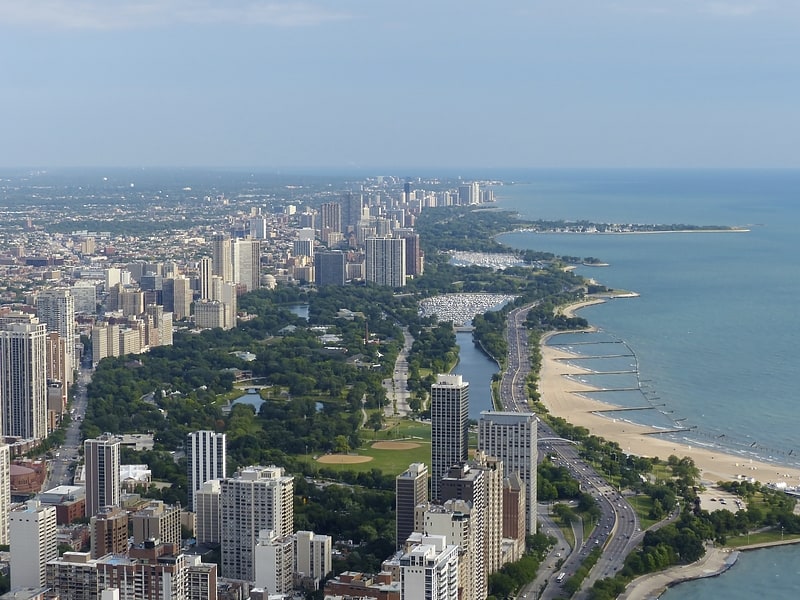
Vast public space with a zoo and museums. Lincoln Park is a 1,208-acre park situated along Lake Michigan on the North Side of Chicago, Illinois. Named after US President Abraham Lincoln, it is the city's largest public park and stretches for seven miles from Grand Avenue on the south to near Ardmore Avenue on the north, just north of the Lake Shore Drive terminus at Hollywood Avenue. Several museums and a zoo are located between North Avenue and Diversey Parkway in the eponymous neighborhood. Further to the north, the park is characterized by parkland, beaches, recreational areas, nature reserves, and harbors. To the south, there is a more narrow strip of beaches east of Lake Shore Drive, almost to downtown. With 20 million visitors per year, Lincoln Park is the second-most-visited city park in the United States, behind Central Park.
The park's recreational facilities include baseball/softball fields, basketball courts, beach volleyball courts, cricket pitches, football/soccer fields, a golf course, lacrosse fields, rugby pitches, tennis courts, volleyball courts, field houses, a target archery field, a skate park, and a driving range.
The park also features several harbors with boating facilities, as well as public beaches for swimming. There are landscaped gardens, public art, bird refuges, a zoo, the Lincoln Park Conservatory, the Chicago History Museum, the Peggy Notebaert Nature Museum, the Alfred Caldwell Lily Pool, and a theater on the lake with regular outdoor performances held during the summer.[8]
Michigan Avenue
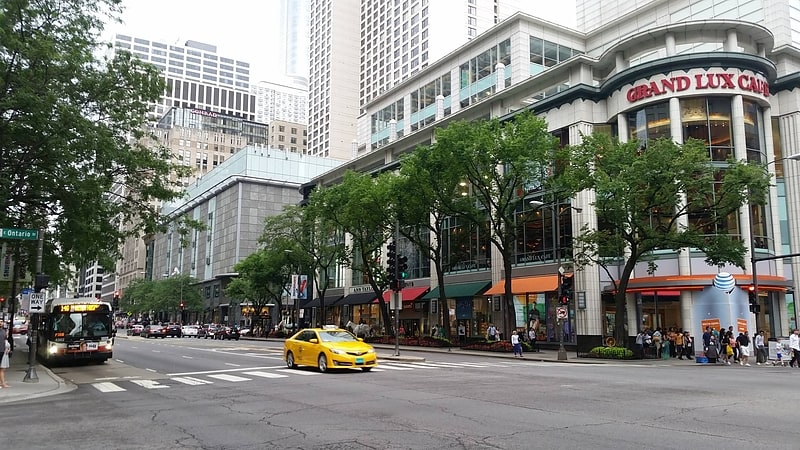
Street in Chicago, Illinois. Michigan Avenue is a north-south street in Chicago which runs at 100 east on the Chicago grid. The northern end of the street is at Lake Shore Drive on the shore of Lake Michigan in the Gold Coast Historic District. The street's southern terminus is at Sibley Boulevard in the southern suburb of Harvey, though like many Chicago streets it exists in several disjointed segments.
As the home of the Chicago Water Tower, the Art Institute of Chicago, Millennium Park, and the shopping on the Magnificent Mile, it is a street well known to Chicago natives as well as tourists to the city. Michigan Avenue also is the main commercial street of Streeterville. It includes all of the Historic Michigan Boulevard District and most of the Michigan–Wacker Historic District, including the scenic urban space anchored by the DuSable (Michigan Avenue) Bridge.[9]
Address: Michigan Avenue, Chicago (Downtown)
Cloud Gate

Sculpture by Anish Kapoor. Cloud Gate is a public sculpture by Indian-born British artist Anish Kapoor, that is the centerpiece of AT&T Plaza at Millennium Park in the Loop community area of Chicago, Illinois. The sculpture and AT&T Plaza are located on top of Park Grill, between the Chase Promenade and McCormick Tribune Plaza & Ice Rink. Constructed between 2004 and 2006, the sculpture is nicknamed "the Bean" because of its shape, a name Kapoor initially disliked, but later grew fond of. Made up of 168 stainless steel plates welded together, its highly polished exterior has no visible seams. It measures 33 by 66 by 42 feet, and weighs 110 short tons.
Kapoor's design was inspired by liquid mercury and the sculpture's surface reflects and distorts the city's skyline. Visitors are able to walk around and under Cloud Gate's 12-foot high arch. On the underside is the "omphalos", a concave chamber that warps and multiplies reflections. The sculpture builds upon many of Kapoor's artistic themes, and it is popular with tourists as a photo-taking opportunity for its unique reflective properties.
The sculpture was the result of a design competition. After Kapoor's design was chosen, numerous technological concerns regarding the design's construction and assembly arose, in addition to concerns regarding the sculpture's upkeep and maintenance. Various experts were consulted, some of whom believed the design could not be implemented. Eventually, a feasible method was found, but the sculpture's construction fell behind schedule. It was unveiled in an incomplete form during the Millennium Park grand opening celebration in 2004, before being concealed again while it was completed. Cloud Gate was formally dedicated on May 15, 2006, and has since gained considerable popularity, both domestically and internationally.[10]
Address: 201 E Randolph St, 60602 Chicago (Downtown)
Shedd Aquarium

Aquatic creatures from around the world. Shedd Aquarium is an indoor public aquarium in Chicago, Illinois, in the United States. Opened on May 30, 1930, the 5 million US gal aquarium was for some time the largest indoor facility in the world. Today it holds about 32,000 animals.
Shedd Aquarium was the first inland aquarium with a permanent saltwater fish collection. It is located on Lake Michigan, on the Museum Campus Chicago, along with the Adler Planetarium and the Field Museum of Natural History.
In 2015, the aquarium had 2.02 million visitors. It was the most visited aquarium in the U.S. in 2005, and in 2007, it surpassed the Field Museum as the most popular cultural attraction in Chicago. The aquarium contains 1,500 species, including fish, marine mammals, birds, snakes, amphibians, and insects. The aquarium received awards for "best exhibit" from the Association of Zoos and Aquariums (AZA) for Seahorse Symphony in 1999, Amazon Rising in 2001, and Wild Reef in 2004. It was designated a National Historic Landmark in 1987.[11]
Address: 1200 S Lake Shore Dr, 60605 Chicago (Downtown)
Robie House
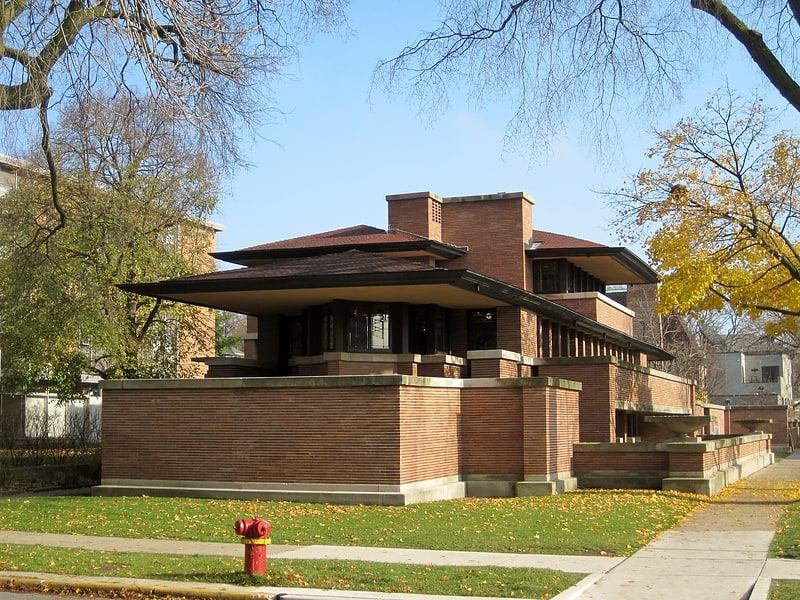
Building in Chicago, Illinois. The Frederick C. Robie House is a U.S. National Historic Landmark now on the campus of the University of Chicago in the South Side neighborhood of Hyde Park in Chicago, Illinois. Built between 1909 and 1910, the building was designed as a single family home by architect Frank Lloyd Wright. It is considered perhaps the finest example of Prairie School, the first architectural style considered uniquely American.
Robie House was designated a National Historic Landmark on November 27, 1963, and was on the first National Register of Historic Places list of October 15, 1966. The house and a selection of seven other properties by Wright were inscribed on the World Heritage List under the title "The 20th-Century Architecture of Frank Lloyd Wright" in July 2019.[12]
Address: 5757 S Woodlawn Ave, 60637 Chicago (South Side)
Wonder Works
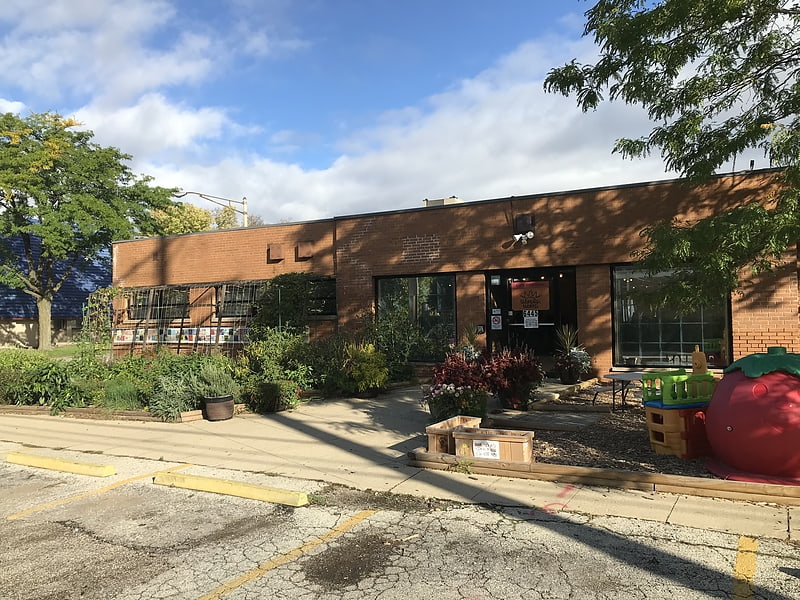
Wonder Works is a children's museum, a non-profit corporation established in 2002, located in the village of Oak Park, Illinois. It is the successor to the Children's Museum of Oak Park, established in 1993. The museum is dedicated to the principle of offering a fun, largely self-directed playing and learning place for children.
Occupying its own building in one of the village's business districts, the museum attracted seventy thousand visitors in 2017. They enjoyed the facilities as drop-in visitors, as museum members, as birthday party invitees, or as special-event attendees.
The museum funds its operations by means of the sale of visitor day passes, yearly memberships, proceeds from special events, and fundraising. Special events generally include value-added educational programs for adults and kids, with most special events being included with general admission.
Wonder Works is managed by a board of directors comprising members of the local community; a CEO; DOO, museum floor managers; an education team, and a number of full-, part-time, or volunteer associates in various roles.
The museum hosts an annual event called "Off the Wall", in which local teens created a mural under the direction of local artist Carolyn Elaine.[13]
Address: 6445 W North Ave, 60302 Oak Park
State Street
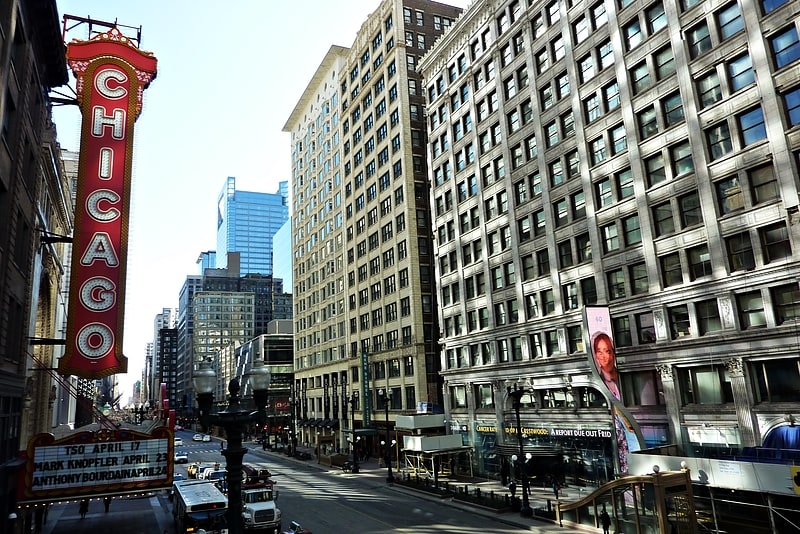
Street. State Street is a large south-north street, also one of the main streets, in Chicago, Illinois, USA and its south suburbs. Its intersection with Madison Street has marked the base point for Chicago's address system since 1909. State begins in the north at North Avenue, the south end of Lincoln Park, runs south through the heart of the Chicago Loop, and ends at the southern city limits, intersecting 127th Street along the bank of the Little Calumet River. It resumes north of 137th Street in Riverdale and runs south intermittently through Chicago's south suburbs until terminating at New Monee Road in Crete, Illinois.
From north to south, State Street traverses the following community areas of Chicago: Near North Side to the Chicago River, Chicago Loop to Roosevelt Road, Near South Side to 26th Street, Douglas to 39th Street, Grand Boulevard to 51st Street, Washington Park to 63rd Street, Grand Crossing to 79th Street, Chatham to 91st Street, Roseland to 115th Street, and West Pullman to 127th Street, where it terminates across from Riverdale Bend Woods. The street runs parallel and adjacent to the Dan Ryan Expressway from 65th Street south to just beyond 95th Street, where State Street crosses the I-94 Bishop Ford Memorial Freeway to enter Roseland.[14]
Address: State St, Chicago (Downtown)
Museum of Science and Industry

Interactive educational museum. The Museum of Science and Industry is a science museum located in Chicago, Illinois, in Jackson Park, in the Hyde Park neighborhood between Lake Michigan and The University of Chicago. It is housed in the former Palace of Fine Arts from the 1893 World's Columbian Exposition. Initially endowed by Julius Rosenwald, the Sears, Roebuck and Company president and philanthropist, it was supported by the Commercial Club of Chicago and opened in 1933 during the Century of Progress Exposition.
Among the museum's exhibits are a full-size replica coal mine, German submarine U-505 captured during World War II, a 3,500-square-foot (330 m2) model railroad, the command module of Apollo 8, and the first diesel-powered streamlined stainless-steel passenger train (Pioneer Zephyr).
Chevy Humphrey became president and CEO of the private, non-profit museum in January 2021.[15]
Address: 5700 S Lake Shore Dr, 60637 Chicago (South Side)
Northerly Island
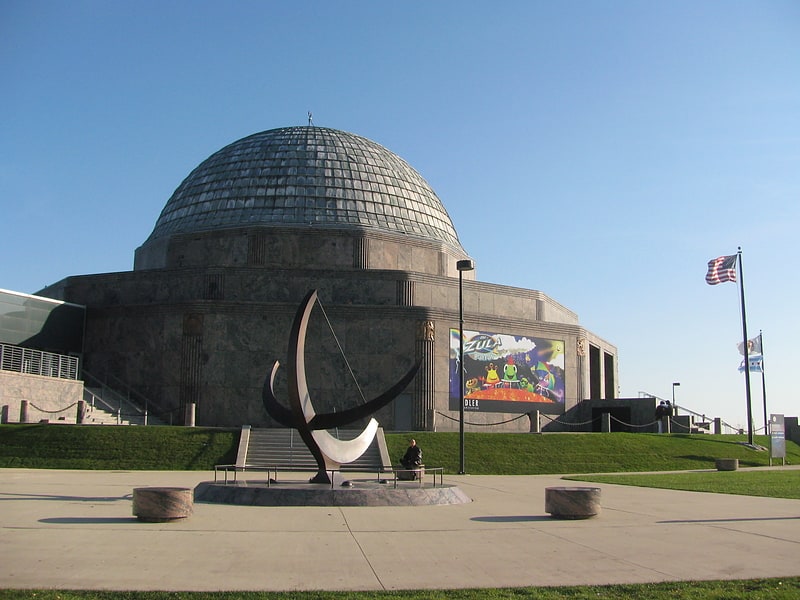
Island in Lake Michigan. Northerly Island is a 91-acre man-made peninsula along Chicago's Lake Michigan lakefront. The site of the Adler Planetarium, Northerly Island connects to the mainland through a narrow isthmus along Solidarity Drive. This street is dominated by Neoclassical sculptures of Tadeusz Kościuszko, Karel Havlíček Borovský and Copernicus. With the demolition of Meigs Field Airport, Northerly Island is now a part of the Museum Campus and has been converted into parkland. A semi-temporary concert venue, the Huntington Bank Pavilion, occupies part of the site of the former airport.[16]
Address: S. Lynn White Dr., 60605 Chicago (Downtown)
Buckingham Fountain
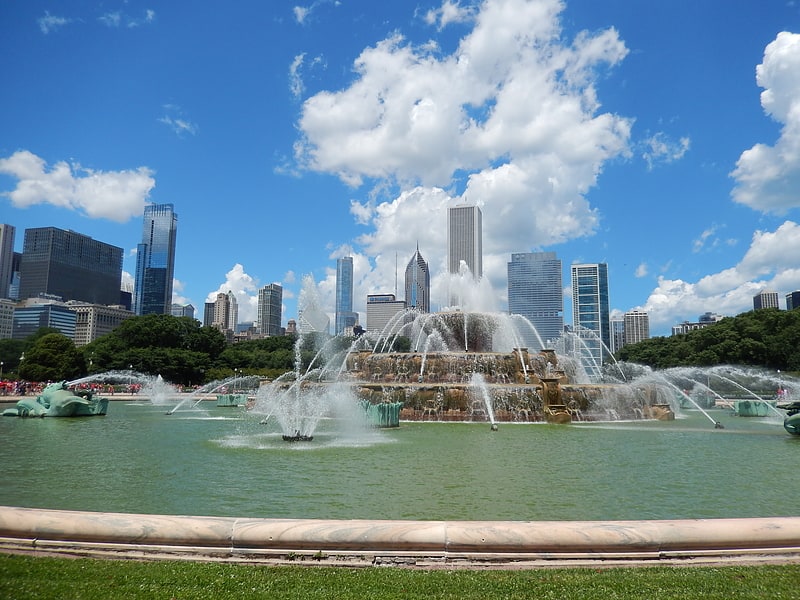
Elaborate rococo landmark from 1927. Buckingham Fountain is a Chicago Landmark in the center of Grant Park, and between Queen's Landing and Congress Parkway. Dedicated in 1927, it is one of the largest fountains in the world. Built in a rococo wedding cake style and inspired by the Latona Fountain at the Palace of Versailles, it is designed to allegorically represent nearby Lake Michigan. It operates from May to mid-October, with regular water shows and evening color-light shows. During the winter, the fountain is decorated with festival lights.[17]
Address: Grant Park, 60605 Chicago (Downtown)
Swedish American Museum
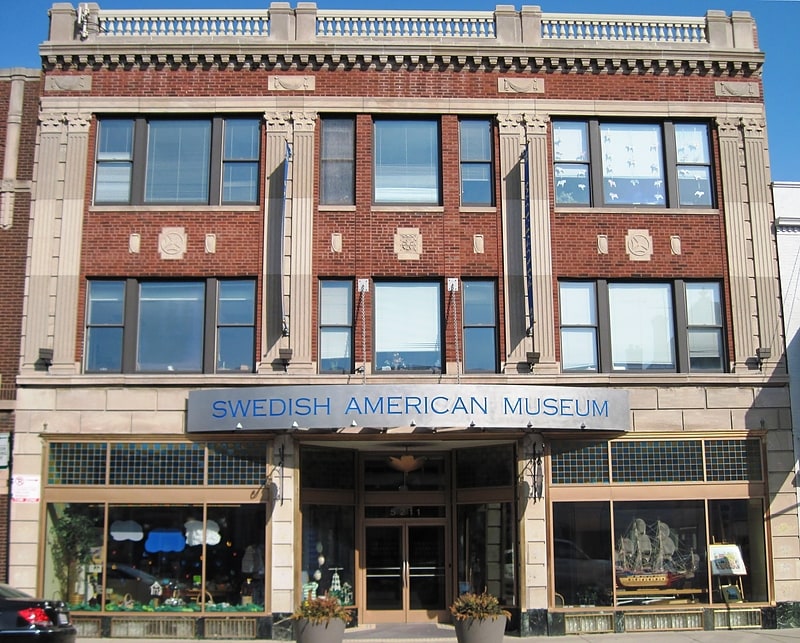
Museum in Chicago, Illinois. Swedish American Museum is a museum of Swedish American topics and the Swedish emigration to the United States, located in the Andersonville neighborhood of Chicago.
The Swedish American Museum in Chicago was founded by Kurt Mathisson in 1976. It moved to its current location on 5211 North Clark Street in 1987. King Carl XVI Gustaf of Sweden was present at the museum's founding and at its move to its new home. The museum is housed in a 24,000-square-foot (2,200 m2), three-story building and has a collection of approximately 12,000 objects. It is a core member of the Chicago Cultural Alliance, a consortium of 25 ethnic museums and cultural centers in Chicago.
The iconic water tower above the museum was removed on March 20, 2014, after being damaged during the harsh winter.[18]
Address: 5211 N Clark St, 60640-2101 Chicago (Far North Side)
Crown Fountain
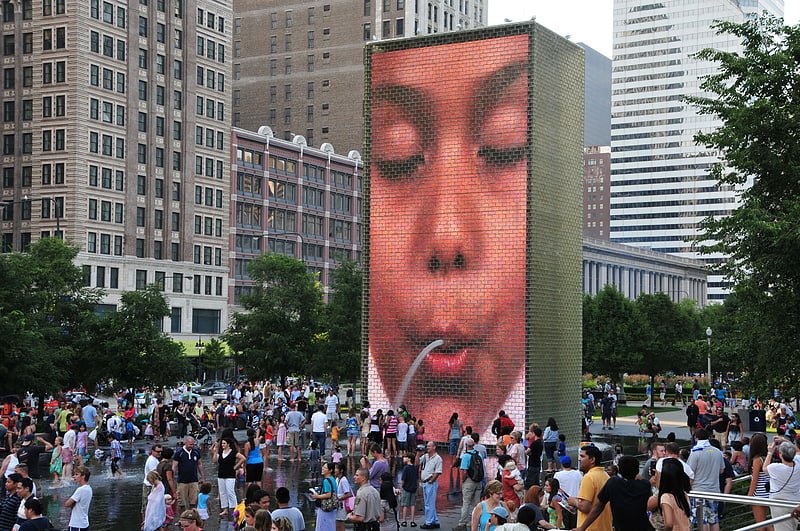
Large LED sculpture with reflecting pool. Crown Fountain is an interactive work of public art and video sculpture featured in Chicago's Millennium Park, which is located in the Loop community area. Designed by Spanish artist Jaume Plensa and executed by Krueck and Sexton Architects, it opened in July 2004. The fountain is composed of a black granite reflecting pool placed between a pair of glass brick towers. The towers are 50 feet tall, and they use light-emitting diodes to display digital videos on their inward faces. Construction and design of the Crown Fountain cost $17 million. The water operates from May to October, intermittently cascading down the two towers and spouting through a nozzle on each tower's front face.
Residents and critics have praised the fountain for its artistic and entertainment features. It highlights Plensa's themes of dualism, light, and water, extending the use of video technology from his prior works. Its use of water is unique among Chicago's many fountains, in that it promotes physical interaction between the public and the water. Both the fountain and Millennium Park are highly accessible because of their universal design.
Crown Fountain has been one of the most controversial of all the Millennium Park features. Before it was even built, some were concerned that the sculpture's height violated the aesthetic tradition of the park. After construction, surveillance cameras were installed atop the fountain, which led to a public outcry (and their quick removal).
However, the fountain has survived its contentious beginnings to find its way into Chicago pop culture. It is a popular subject for photographers and a common gathering place. While some of the videos displayed are of scenery, most attention has focused on its video clips of local residents. The fountain is a public play area and offers people an escape from summer heat, allowing children to frolic in the fountain's water.[19]
Address: 201 E Randolph St, 60601-6530 Chicago (Downtown)
Lincoln Park Zoo
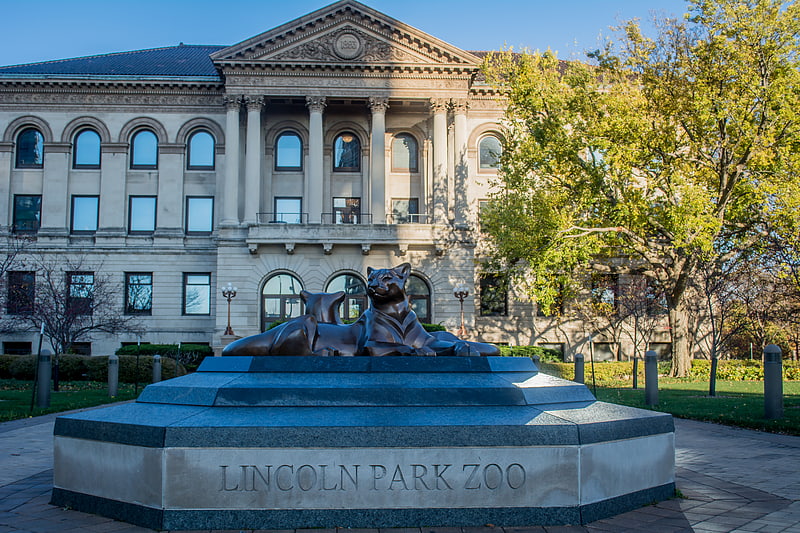
Free zoo with an interactive farm. Lincoln Park Zoo is a 35-acre zoo in Lincoln Park, Chicago, Illinois. The zoo was founded in 1868, making it the fourth oldest zoo in North America. It is also one of a few free admission zoos in the United States. The zoo is an accredited member of the Association of Zoos and Aquariums.
Lincoln Park Zoo is home to a wide variety of animals. The zoo's exhibits include big cats, polar bears, penguins, gorillas, reptiles, monkeys, and other species totaling about 1,100 animals from some 200 species. Also located in Lincoln Park Zoo is a burr oak tree which dates to 1830, three years before the city of Chicago was organized.[20]
Address: 2234 N Cannon Dr, 60614 Chicago (North Side)
Lurie Garden
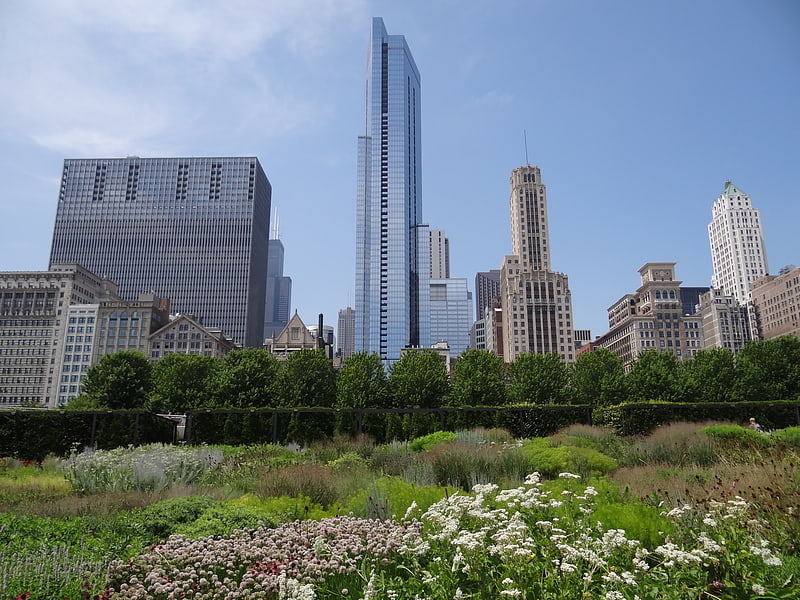
Garden in Chicago, Illinois. Lurie Garden is a 2.5-acre garden located at the southern end of Millennium Park in the Loop area of Chicago in Cook County, Illinois, United States. Designed by GGN, Piet Oudolf, and Robert Israel, it opened on July 16, 2004. The garden is a combination of perennials, bulbs, grasses, shrubs and trees. It is the featured nature component of the world's largest green roof. The garden cost $13.2 million and has a $10 million endowment for maintenance and upkeep. It was named after Ann Lurie, who donated the $10 million endowment. For visitors, the garden features guided walks, lectures, interactive demonstrations, family festivals and picnics.
The Garden is composed of two "plates" protected on two sides by large hedges. The dark plate depicts Chicago's history by presenting shade-loving plant material. The dark plate has a combination of trees that will provide a shade canopy for these plants when they fill in. The light plate, which includes no trees, represents the city's future with sun-loving perennials that thrive in the heat and the sun.[21]
Address: Millennium Park, 60602 Chicago (Downtown)
John Hancock Center
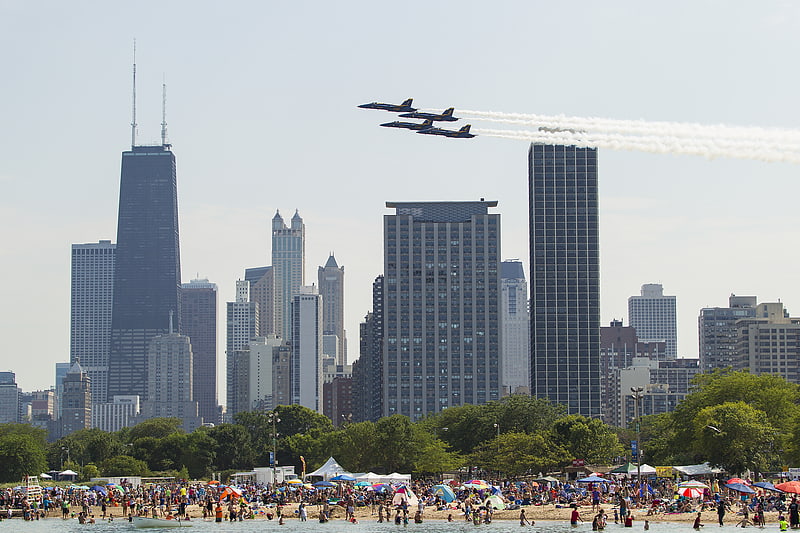
Sky-high city views from 94th-floor deck. The John Hancock Center is a 100-story, 1,128-foot supertall skyscraper located in Chicago, Illinois. Located in the Magnificent Mile district, its name was changed to 875 North Michigan Avenue on February 12, 2018. Despite this, the building is still colloquially called the John Hancock Center.
It was constructed under the supervision of Skidmore, Owings and Merrill, with Peruvian-US chief designer Bruce Graham and Bangladeshi structural engineer Fazlur Rahman Khan. When the building topped out on May 6, 1968, it was the second-tallest building in the world after the Empire State Building, the tallest in Chicago, and the tallest outside New York City. It is currently the fifth-tallest building in Chicago and the thirteenth-tallest in the United States, behind the Aon Center in Chicago and ahead of the Comcast Technology Center in Philadelphia. When measured to the top of its antenna masts, it stands at 1,500 feet (457 m). The building is home to several offices and restaurants, as well as about 700 condominiums, and at the time of its completion contained the highest residence in the world. The building was named for John Hancock Mutual Life Insurance Company, a developer and original tenant of the building, which itself was named for the U.S. Founding Father John Hancock. In 2018, John Hancock Insurance requested that its name be removed and the owner is seeking another naming rights deal.
From the 95th floor restaurant, diners can look out at Chicago and Lake Michigan. The observatory (360 Chicago), which competes with the Willis Tower's Skydeck, has a 360° view of the city, up to four states, and a distance of over 80 miles (130 km). 360 Chicago is home to TILT, a moving platform that leans visitors over the edge of the skyscraper to a 30-degree angle, a full bar with local selections, Chicago's only open-air SkyWalk, and also features free interactive high definition touch screens in six languages. The 44th-floor sky lobby features America's highest indoor swimming pool.[22]
Jay Pritzker Pavilion
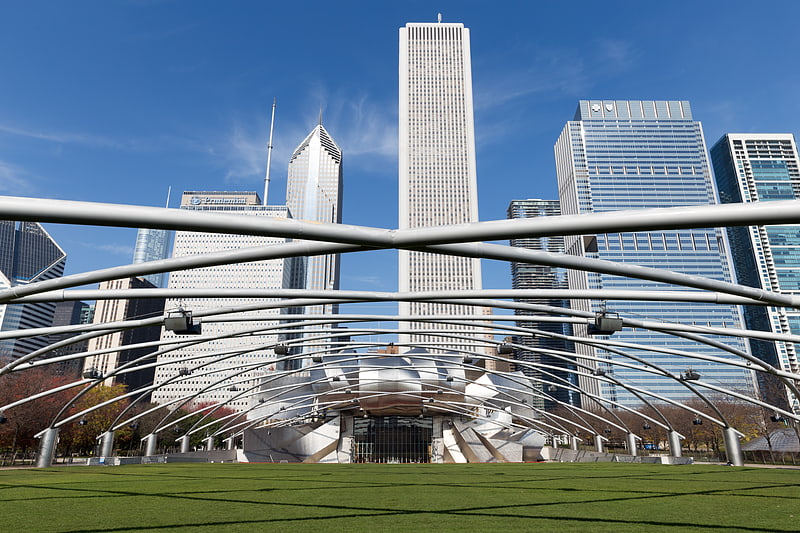
Bandshell in the park with entertainment. Jay Pritzker Pavilion, also known as Pritzker Pavilion or Pritzker Music Pavilion, is a bandshell in Millennium Park in the Loop community area of Chicago in Cook County, Illinois, United States. It is located on the south side of Randolph Street and east of the Chicago Landmark Historic Michigan Boulevard District. The pavilion was named after Jay Pritzker, whose family is known for owning Hyatt Hotels. The building was designed by architect Frank Gehry, who accepted the design commission in April 1999; the pavilion was constructed between June 1999 and July 2004, opening officially on July 16, 2004.
Pritzker Pavilion serves as the centerpiece for Millennium Park and is the home of the Grant Park Symphony Orchestra and Chorus and the Grant Park Music Festival, the nation's only remaining free outdoor classical music series. It also hosts a wide range of music series and annual performing arts events. Performers ranging from mainstream rock bands to classical musicians and opera singers have appeared at the pavilion, which even hosts physical fitness activities such as yoga. All rehearsals at the pavilion are open to the public; trained guides are available for the music festival rehearsals, which are well-attended.
Millennium Park is part of the larger Grant Park. The pavilion, which has a capacity of 11,000, is Grant Park's small event outdoor performing arts venue, and complements Petrillo Music Shell, the park's older and larger bandshell. Pritzker Pavilion is built partially atop the Harris Theater for Music and Dance, the park's indoor performing arts venue, with which it shares a loading dock and backstage facilities. Initially the pavilion's lawn seats were free for all concerts, but this changed when Tori Amos performed the first rock concert there on August 31, 2005.
The construction of the pavilion created a legal controversy, given that there are historic limitations on the height of buildings in Grant Park. To avoid these legal restrictions, the city classifies the bandshell as a work of art rather than a building. With several design and assembly problems, the construction plans were revised over time, with features eliminated and others added as successful fundraising allowed the budget to grow. In the end, the performance venue was designed with a large fixed seating area, a Great Lawn, a trellis network to support the sound system and a signature Gehry stainless steel headdress. It features a sound system with an acoustic design that replicates an indoor concert hall sound experience. The pavilion and Millennium Park have received recognition by critics, particularly for their accessibility; an accessibility award ceremony held at the pavilion in 2005 described it as "one of the most accessible parks – not just in the United States but possibly the world".[23]
Humboldt Park

Park in Chicago, Illinois. Humboldt Park is a 207-acre park located at 1400 North Sacramento Avenue on the West Side of Chicago, Illinois.
The park was named for Alexander von Humboldt, a German naturalist and botanist.[24]
Address: 1400 N Sacramento Ave, 60622-2799 Chicago (West Side)
National Hellenic Museum
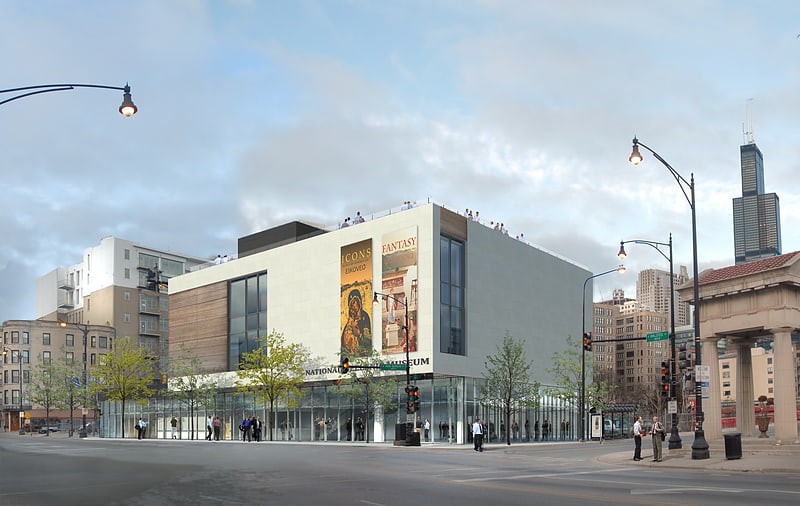
Cultural institute in Chicago, Illinois. The National Hellenic Museum is the second oldest American institution dedicated to displaying and celebrating the cultural contributions of Greeks and Greek-Americans. Formerly known as the Hellenic Museum and Cultural Center, the National Hellenic Museum is located in Chicago’s Greektown, at the corner of Halsted and Van Buren Streets. The National Hellenic Museum has recently undergone a modernization program that cumulated in the museum moving to its current building in December 2011. The official opening of the NHM took place on December 10th, 2011 and proved to be a marked event within the Greek community of Chicago.
Created to promote understanding of the rich cultural traditions of ancient and contemporary Greece, as well as a focus on the Greek-American immigrant experience, the National Hellenic Museum has become a fixture in the Greek Community in Chicago.[25]
Address: 333 S Halsted St, 60661 Chicago (West Side)
Garfield Park Conservatory
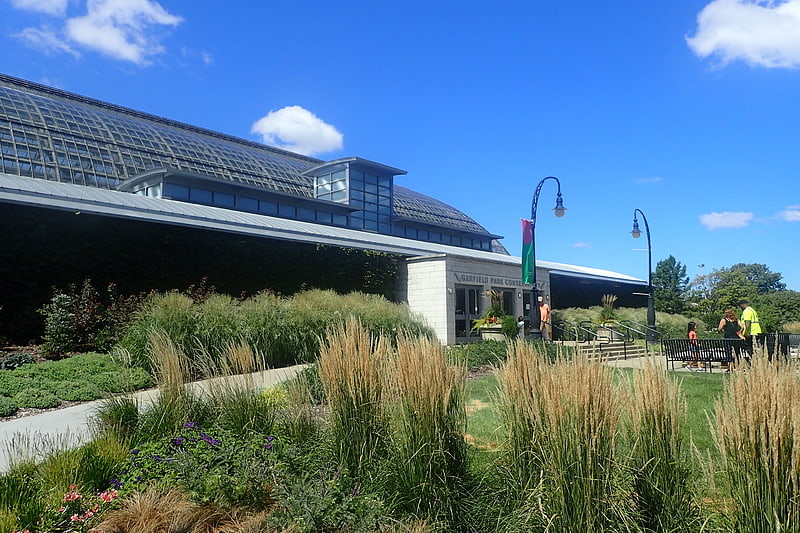
Garfield Park Conservatory, located in Garfield Park in Chicago, is one of the largest greenhouse conservatories in the United States. Often referred to as "landscape art under glass", the Garfield Park Conservatory occupies approximately 4.5 acres inside and out and contains a number of permanent plant exhibits incorporating specimens from around the world, including some cycads that are over 200 years old.
Along with the Lincoln Park Conservatory on Chicago's north side, the Garfield Park Conservatory provides significant horticultural collections, educational programs and community outreach efforts.[26]
Address: 300 N Central Park Ave, 60624-1996 Chicago (West Side)
Michigan Avenue Bridge
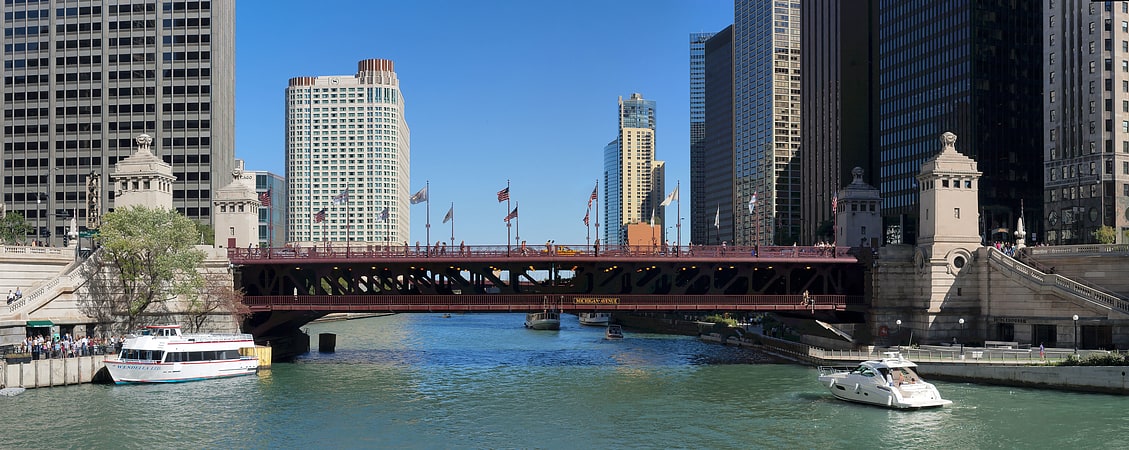
Historic drawbridge with decorative work. The DuSable Bridge is a bascule bridge that carries Michigan Avenue across the main stem of the Chicago River in downtown Chicago, Illinois, United States. The bridge was proposed in the early 20th century as part of a plan to link Chicago's south side and north side parks with a grand boulevard. Construction of the bridge started in 1918, it opened to traffic in 1920, and decorative work was completed in 1928. The bridge provides passage for vehicles and pedestrians on two levels. An example of a fixed trunnion bascule bridge, it may be raised to allow tall ships and boats to pass underneath. The bridge is included in the Michigan–Wacker Historic District and has been designated as a Chicago Landmark.
The location is significant in the early history of Chicago, connecting on the north near the 1780s homestead site of Jean Baptiste Point du Sable and on the south the early 19th century site of Fort Dearborn. Events from the city's past are commemorated with sculptures and plaques on the bridge, and exhibits in the McCormick Bridgehouse & Chicago River Museum—housed in one of the bridge tender houses—detail the history of the Chicago River.[27]
Address: 333 N Michigan Ave, 60601-3901 Chicago (Downtown)
Money Museum
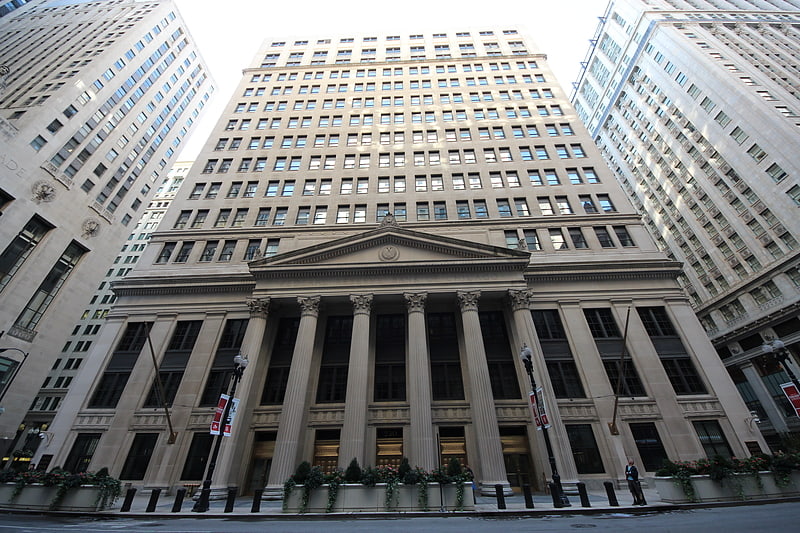
The Federal Reserve Bank of Chicago is one of twelve regional Reserve Banks that, along with the Federal Reserve Board of Governors, make up the United States' central bank. The Chicago Reserve Bank serves the Seventh Federal Reserve District, which encompasses the northern portions of Illinois and Indiana, southern Wisconsin, the Lower Peninsula of Michigan, and the state of Iowa. In addition to participation in the formulation of monetary policy, each Reserve Bank supervises member banks and bank holding companies, provides financial services to depository institutions and the U.S. government, and monitors economic conditions in its District.[28]
Address: 230 S La Salle St, 60604-1413 Chicago (Downtown)
Chicago Water Tower

Art gallery inside a historic landmark. The Chicago Water Tower is a contributing property and landmark in the Old Chicago Water Tower District in Chicago, Illinois, United States, that is listed on the National Register of Historic Places. Built to enclose the tall machinery of a powerful water pump in 1869, it became particularly well known when it survived the Great Chicago Fire of 1871, although the area around it was burnt to the ground.[29]
Address: 806 N Michigan Ave, 60611-2103 Chicago (Downtown)
Chicago Children's Museum
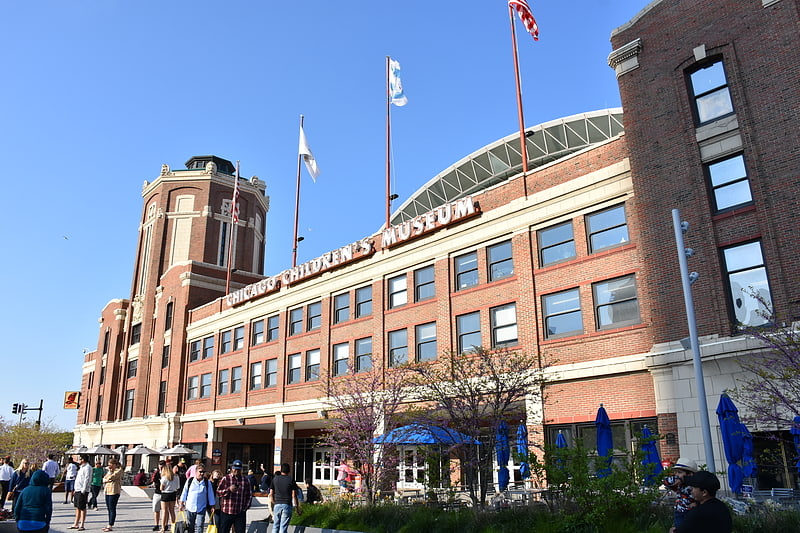
Museum in Chicago, Illinois. The Chicago Children's Museum is located at Navy Pier in Chicago, Illinois. It was founded in 1982 by The Junior League of Chicago who were responding to programming cutbacks in the Chicago Public Schools. Originally housed in two hallways of the Chicago Public Library, it soon began to offer trunk shows and traveling exhibits in response to capacity crowds on-site.
The museum moved a number of times over its initial years of existence while it continued to search for a permanent home. In 1995, the Museum thought it found that home when it reopened as an anchor tenant at Navy Pier on Lake Michigan. The new facility offered 57,000 square feet (5,300 m2) of exhibition space and included three floors of educational exhibits, public programs and special events. Upon the move to the Pier, the expansion made it the fourth largest children's museum in the United States. The museum serves more than 650,000 people, both at its Navy Pier location and in communities in and around Chicago, each year. While the Museum has an admission charge, it currently provides free admission to children 15 and under each Thursday from 5 p.m. to 8 p.m. and all-day on the first Sunday of each month.[30]
Address: 700 E Grand Ave, 60611-3436 Chicago (Downtown)
Driehaus Museum
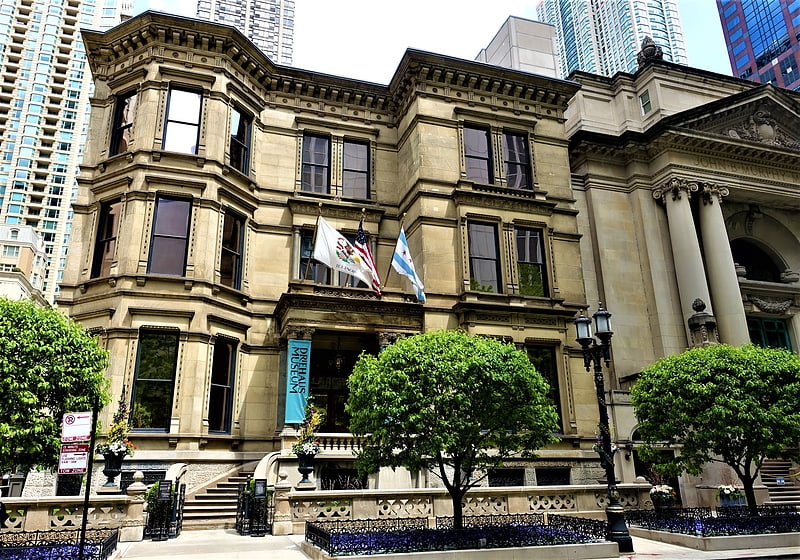
Museum in Chicago, Illinois. The Richard H. Driehaus Museum is a museum located at 40 East Erie Street on the Near North Side in Chicago, Illinois, near the Magnificent Mile. The museum is housed within the historic Samuel M. Nickerson House, the 1883 residence of a wealthy Chicago banker. Although the mansion has been restored, the Driehaus Museum does not re-create the Nickerson period but rather broadly interprets and displays the prevailing design, architecture, and decorating tastes of Gilded Age America and the art nouveau era in permanent and special exhibitions.
The interiors are replete with marble, onyx, carved exotic and domestic woods, glazed tiles, and stained glass. On display are original furnishings from the Nickerson era along with American and European decorative arts of the late 19th and early 20th centuries, including art nouveau furnishings and a number of works by Louis Comfort Tiffany. The museum is named after its founder, the Chicago businessman, philanthropist, and art collector Richard H. Driehaus. The artworks on display in the museum are selections from the private Driehaus Collection of Fine and Decorative Arts.[31]
Address: 40 E Erie St, 60611 Chicago (Downtown)
BP Pedestrian Bridge
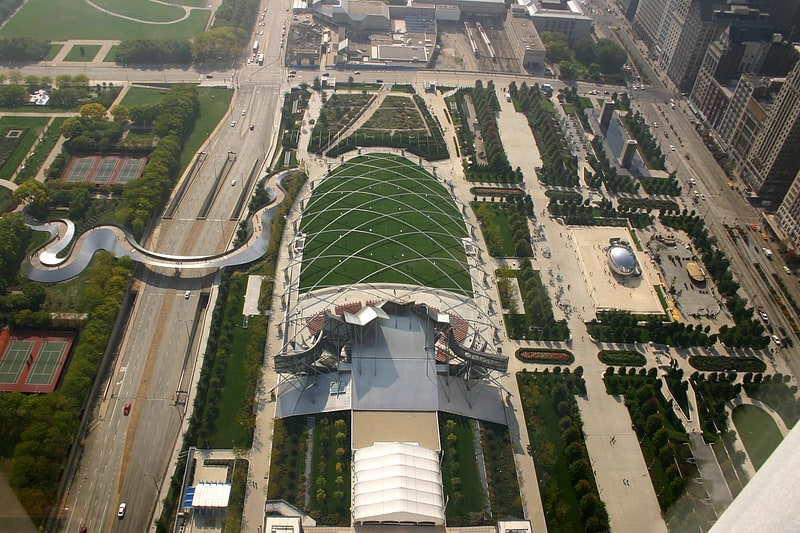
Winding footbridge by architect Gehry. The BP Pedestrian Bridge, or simply BP Bridge, is a girder footbridge in the Loop community area of Chicago, United States. It spans Columbus Drive to connect Maggie Daley Park with Millennium Park, both parts of the larger Grant Park. Designed by Pritzker Prize-winning architect Frank Gehry and structurally engineered by Skidmore, Owings and Merrill, it opened along with the rest of Millennium Park on July 16, 2004. Gehry had been courted by the city to design the bridge and the neighboring Jay Pritzker Pavilion, and eventually agreed to do so after the Pritzker family funded the Pavilion.
Named for energy firm BP, which donated $5 million toward its construction, it is the first Gehry-designed bridge to have been completed. BP Bridge is described as snakelike because of its curving form. Designed to bear a heavy load without structural problems caused by its own weight, it has won awards for its use of sheet metal. The bridge is known for its aesthetics, and Gehry's style is seen in its biomorphic allusions and extensive sculptural use of stainless steel plates to express abstraction.
The pedestrian bridge serves as a noise barrier for traffic sounds from Columbus Drive. It is a connecting link between Millennium Park and destinations to the east, such as the nearby lakefront, other parts of Grant Park and a parking garage. BP Bridge uses a concealed box girder design with a concrete base, and its deck is covered by hardwood floor boards. It is designed without handrails, using stainless steel parapets instead. The total length is 935 feet (285 m), with a five percent slope on its inclined surfaces that makes it barrier free and accessible. Although the bridge is closed in winter because ice cannot be safely removed from its wooden walkway, it has received favorable reviews for its design and aesthetics.[32]
Address: 201 E Randolph St, 60601 Chicago (Downtown)
First Saint Paul's Evangelical Lutheran Church
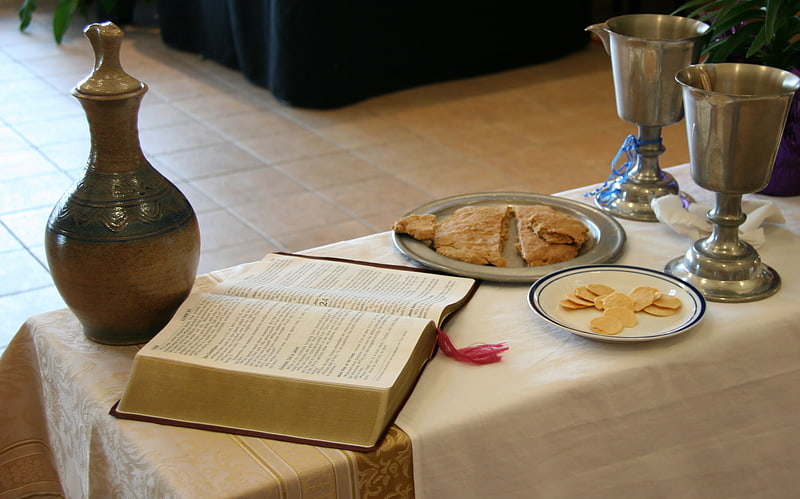
The Evangelical Lutheran Church in America is a mainline Protestant Lutheran church headquartered in Chicago, Illinois. The ELCA was officially formed on January 1, 1988, by the merging of three Lutheran church bodies. As of 2020, it has approximately 3.14 million baptized members in 8,894 congregations.
In 2015, Pew Research estimated that 1.4 percent of the U.S. population self-identifies with the ELCA. It is the seventh-largest Christian denomination by reported membership, and the largest Lutheran denomination in the United States. The next two largest Lutheran denominations are the Lutheran Church–Missouri Synod (LCMS) (with over 1.8 million members) and the Wisconsin Evangelical Lutheran Synod (WELS) (with approximately 350,000 members). There are also many smaller Lutheran church bodies in the United States, some of which were formed by dissidents to the major 1988 merger.
The ELCA belongs to the World Council of Churches, the National Council of Churches of Christ in the USA, and the Lutheran World Federation. The ELCA is in full communion with the Episcopal Church, Moravian Church, Presbyterian Church (USA), Reformed Church in America, United Church of Christ, and the United Methodist Church.[33]
Address: 1301 North La Salle Boulevard, Chicago (Downtown)
Museum of Contemporary Art

Museum in Chicago, Illinois. The Museum of Contemporary Art Chicago is a contemporary art museum near Water Tower Place in downtown Chicago in Cook County, Illinois, United States. The museum, which was established in 1967, is one of the world's largest contemporary art venues. The museum's collection is composed of thousands of objects of Post-World War II visual art. The museum is run gallery-style, with individually curated exhibitions throughout the year. Each exhibition may be composed of temporary loans, pieces from their permanent collection, or a combination of the two.
The museum has hosted several notable debut exhibitions including Frida Kahlo's first U.S. exhibition and Jeff Koons' first solo museum exhibition. Koons later presented an exhibit at the Museum that broke the museum's attendance record. The current record for the most attended exhibition is the 2017 exhibition of Takashi Murakami work. The museums collection, which includes Jasper Johns, Andy Warhol, Cindy Sherman, Kara Walker, and Alexander Calder, contains historical samples of 1940s–1970s late surrealism, pop art, minimalism, and conceptual art; notable holdings 1980s postmodernism; as well as contemporary painting, sculpture, photography, video, installation, and related media. It also presents dance, theater, music, and multidisciplinary arts.
The current location at 220 East Chicago Avenue is in the Streeterville neighborhood of the Near North Side community area. Josef Paul Kleihues designed the current building after the museum conducted a 12-month search, reviewing more than 200 nominations. The museum was originally located at 237 East Ontario Street, which was originally designed as a bakery. The current building is known for its signature staircase leading to an elevated ground floor, which has an atrium, the full glass-walled east and west façades giving a direct view of the city and Lake Michigan.[34]
Address: 220 E Chicago Ave, 60611 Chicago (Downtown)
Fab Lab MSI

Fab Lab MSI is a small scale workshop that uses various machines to create both prototypes for individuals and small projects for museum members and visitors. The idea behind the Fab Lab is to be able to learn how to use various machines to build "almost anything".
The lab is located in the innovations (the ball enterprise) section of the museum, next to the Toymaker 3000.
This Fab Lab is part of 34 other Fab Labs found in 10 countries, all of which started in the Media Lab at MIT. These labs are all interconnected, although the idea is for each lab to become independent yet keeping with the same concepts and ideas.
The equipment found in the Fab Lab at MSI includes: